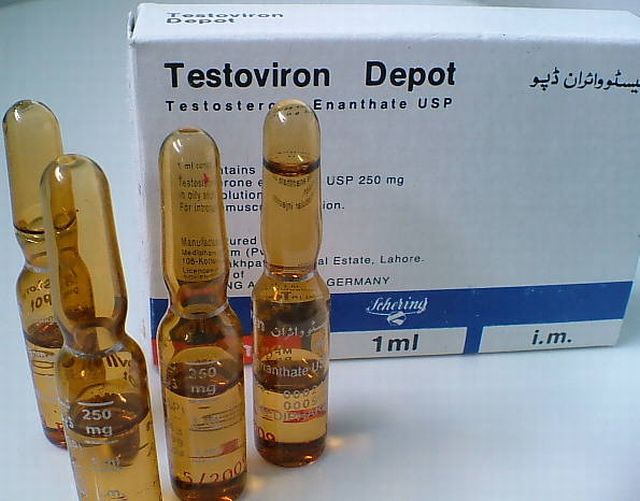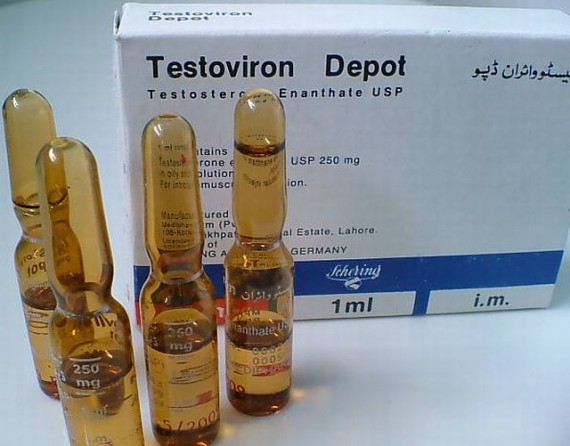
Dr. Michael Scally is a medical expert on testosterone replacement therapy (TRT) and anabolic steroid side effects. He is available for phone consultations. Email him at mscally@hptaxis.com. I highly recommend anyone who cares about their bodies and health to pick his brain since he truly is one of the world’s experts on androgens.
The first part of the interview is found here.
NV: Can somebody on testosterone replacement become less fertile? If a man wants to impregnate his wife after, let us say, a year of testosterone replacement, is there any risk for that man to become less fertile to his wife?
MS: Testicular size and consistency often diminish, and men should be advised that fertility would be greatly compromised during testosterone replacement therapy because of downregulation of LH and FSH.
The general rule is they will become less fertile. But you cannot depend on its use as a fertility drug. And that is where we come in with contraceptive studies. We have many, many contraceptive studies that use testosterone cypionate at 200 mg a week and find that, yes, it decreases fertility. But there is still a subset of men that still produce sperm that are fertile.
NV: Are these men good candidates for a protocol to reset their HPGA?
MS: We have had many men who come to the clinic with the actual complaint that they were using anabolic steroids, or they were using testosterone, and they now want to get their wife pregnant. Although many will return to normal after stopping TRT, this period can be lengthy.
The amazing thing to me is that the number of people that come to me, who have seen the doctor, who are either non-prescription or prescription anabolic steroid users, testosterone with or without combination of anabolic steroids, who have the problem of infertility; and their doctors have no idea what to do, except to do nothing. But on top of this are all the psychological problems and effects that come along with doing nothing as a consequence of anabolic steroid-induced hypogonadism. The HPTA protocol has restored fertility as well as decreased the time substantially.

NV: Can you expand about resetting the HPGA?
The word resetting is a misnomer, though recent studies published in the New England Journal of Medicine (NEJM) do indicate this possible. In 2007, the NEJM reports on the resetting of the HPTA after TRT for adult onset idio-pathic hypogonadism. This is the first report demonstrating HPTA plasticity in adulthood. The term I prefer is HPTA functionality and restoration.
There are clear conditions under which testosterone requires administration for life-long treatment. However, there are increasing numbers of individuals being treated with TRT who do not fall under these disorders. TRT is being prescribed more and more for late onset hypogonadism. This is called by many other names, including andropause, androgen deficiency of the aging male, and others.
There are no consequences of the decline in serum testosterone with age that are known with certainty. Several parallels exist between the effects of aging and those of hypogonadism, which suggest that the decline in serum testosterone might be a cause of several effects of aging. Since the long-term effects of androgen treatment for late onset hypogonadism or andropause are not well-known, I discontinue therapy on an approximate annual basis to ensure HPTA normalization—functionality. This allows the patient the autonomy to stop therapy should the need arise.
What is clear is that upon stopping testosterone or anabolic steroids, a period of anabolic steroid-induced hypogonadism ensues. This occurs in one hundred percent of individuals stopping testosterone. The only variables are the duration and severity. The duration of hypogonadism, or the severity of hypogonadism, is typically related to the anabolic steroid drug, dose, and duration.
In other words, one person that is on testosterone for an entire year; they may come back to normal within 1 or 2 months. Another person may take 12, 18 months, or even 3 years to come back to normal. The best studies we have on this are contraceptive studies with testosterone for over a year. And what we find in those studies is that it may take up to three years for a person to return to normal.
If they have been taking those anabolic steroids to improve their body composition, increase the lean body mass, and decrease the body fat, that all goes back to normal after stopping anabolic steroids. But you are also going to be exposed to the other adverse effects of hypogonadism, which include adverse psychological and cardiovascular effects. Some of the adverse psychological effects are depression, decreased cognitive abilities, insomnia, decreased libido, and erection dysfunction. More significantly, after cessation adds the comorbid condition of hypogonadism to their already existing chronic illness.
AAS, including testosterone, licit and illicit, administration induces a state of hypogonadism that continues after their cessation. All compounds classified as androgens or anabolic steroids cause a negative feedback inhibition of the hypothalamic-pituitary testicular axis, suppress endogenous gonadotropin secretion, and as a consequence serum testosterone.
The symptoms of AIH are identical to classical hypogonadism. This problem prevents many of discontinuing testosterone or anabolic steroids. As we have said, there are many reasons for stopping testosterone, including polycythemia, gynecomastia, and other issue as compliance, affordability, and changing life style.
The accepted standard of care within the medical community for anabolic steroid induced hypogonadism is to do nothing with the expectation the individual will return to normal unassisted. But the literature shows this not to be the case.
AIH is critical toward any planned use of AAS or similar compound to effect positive changes in muscle mass and muscle strength as well as an understanding for what has been termed anabolic steroid dependency. The further understanding and treatments that mitigate or prevent AIH could contribute to androgen therapies for wasting associated diseases and stopping nonprescription AAS use.
NV: What is used for restoring the hormonal axis?
MS: A combination of three drugs. The individual use of HCG, clomiphene citrate, and tamoxifen is well-known, well-accepted, and well-tested standards of care treatments in peer-reviewed medical literature for diagnostic testing for underlying pathology of hypogonadism. The HPTA protocol uses the medications human chorionic gonadotropin, clomiphene citrate, and tamoxifen.
The first phase of the HPTA protocol examines the functionality of the testicles by the direct action of HCG. HCG raises sex hormone levels directly through the stimulation of the testes and secondly decreases the production and level of gonadotropin LH. The increase in serum testosterone with the HCG stimulation is useful in determining whether any primary testicular dysfunction is present.
This initial value is a measure of the ability of the testicles to respond to stimulation from HCG. Demonstration of the HPTA functionality is an adequate response of the testicles to raise the serum level of T well into the normal range. If this is observed, HCG is discontinued. The failure of the testes to respond to an HCG challenge is indicative of primary testicular failure. In the simplest terms, the first half of the protocol is to determine testicular production and reserve by direct stimulation with HCG. If one is unable to obtain adequate (normal) levels successfully in the first half, there is little cause or reason to proceed to the second half.
The second phase of the HPTA protocol, clomiphene and tamoxifen, examines the ability of the hypothalamic-pituitary axis to respond to stimulation by producing LH levels within the normal reference range. The clomiphene citrate challenge differentiates secondary hypogonadism. Clomiphene is an antiestrogen, which decreases the estrogen effect in the body. It has a dual effect by stimulating the hypothalamic pituitary area and it has an antiestrogenic effect, so that it decreases the effect of estrogen in the body. Tamoxifen is more of a strict antiestrogen, it decreases the effect of estrogen in the body, and potentiates the action of clomiphene. Tamoxifen and clomiphene citrate compete with estrogen for estrogen receptor binding sites, thus eliminating excess estrogen circulation at the level of the hypothalamus and pituitary, allowing gonadotropin production to resume. Administering them together produces an elevation of LH and secondarily gonadal sex hormones. The administration of clomiphene leads to an appropriate rise in the levels of LH, suggesting that the negative feedback control on the hypothalamus is intact and that the storage and release of gonadotropins by the pituitary is normal. If there was a successful stimulation of testicular T levels by HCG, but an inadequate or no response in LH production, then the patient has hypogonadotropic, secondary, hypogonadism.
In the simplest terms, the second half of the protocol is to determine hypothalamo-pituitary production and reserve with clomiphene and tamoxifen. The physiological type of hypogonadism—hypogonadotropic or secondary—is characterized by abnormal low or low normal gonadotropin (LH) production in response to clomiphene citrate and tamoxifen. In the functional type of hypogonadism, the ability to stimulate the HPTA to produce LH and T levels within the normal reference range occurs.
There is a dearth of good studies in anabolic steroids, both while you are taking them and after you stop them, I think this is going to be something that we are going to need to look at in the future. In fact, we are going to plan on looking at it in our proposed clinical studies that we have with our company for the prevention of anabolic steroid-induced hypogonadism.
Dr Scally’s book “Anabolic Steroids – A Question of Muscle: Human Subject Abuses in Anabolic Steroid Research” is available on Amazon.com
Nelson Vergel’s book “Testosterone: A Man’s Guide- Second Edition” is available on Amazon.com

About the author
Nelson Vergel is the author of "Testosterone: A Man's Guide- Second Edition" and co-author of the book "Built to Survive: A Comprehensive Guide to the Medical Use of Anabolic Therapies, Nutrition and Exercise for HIV (+) men and women", the founder of the Body Positive Wellness Clinic in Houston, and an expert speaker on exercise, nutrition, testosterone replacement, metabolism , sexual function and therapies to increase lean body mass and decrease fat.
No replies yet
Loading new replies...
Join the full discussion at the MESO-Rx →